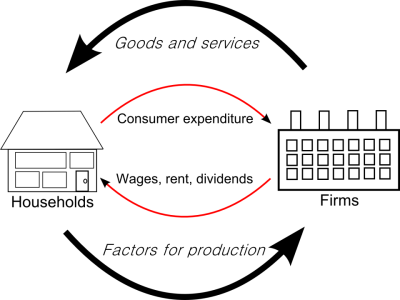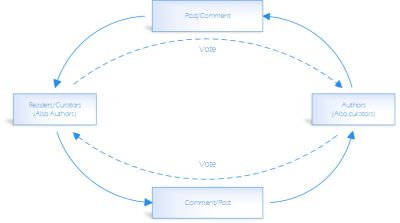Since I started writing my guide in portuguese where I explained what I learned in the first month that I got here at Steemit, every day i learned more about the platform, the blockchain, the dramas, and the community.
After writing this post during the days that the discussion about the implementation of yet another mechanism to further peg the SBD to the value of the dollar, I became increasingly interested in how the Steem ecosystem economy works.
So, here I come, try to explain what gears are behind the blockchain.
But if some economist who is reading this sees that I have said some bullshit, you can call my attention, because I am just a curious Engineer.
What forms the economy of the blockchain Steem
Like all other economies in the modern world, currency is the basis of economics because it is a unit of measure of value for almost all transactions that take place.
A coin is basically a reference, which allows people in a community to have a unit of comparison between products, goods and services that are exchanged within that community.
Currency is what feeds the money flow and the goods flow in an economy:

In the fundamental idea behind Steemit, which is the reward for producing content, we could replace the participants above as follows:
- Firms are the authors
- Households are the curators
- The supply of goods and services (product) are the posts and the market for goods and services (posts and comments) the Steemit page
- Factors for production are votes (effort) and factor inputs market (vote button) is the same page of Steemit.
The red line represents the circulation of money, where companies pay for the effort of the worker, who use the same money to consume from the companies.
In the "real world" economy the currency is the same throughout this cycle. The money that companies pay to households is the same currency households use to consume corporate goods and services.
Around here the essence of this movement is not very different, but there is no clear distinction between Companies and Households. All users can be independent producers and consumers, and the money flow occurs through votes.

This is, in essence, the basis of value distribution here.
However, just like the posts, votes are products. Basically, this base of the system would function as a barter, within a closed system.
The monetary value arises from the moment they are generated outside the basic flow of the economy, the currencies that will represent this value, generated from the use of the computational power of the witnesses, who are responsible for validating the transactions carried out in the Steem blockchain.

Compared with other social media (Facebook, Youtube, Instagram), which has a similar basic economic operation of content exchange by votes, the monetary value of the interactions appear basically through the advertisements.
One of the functions of witnesses is to determine what the voting value is within the blockchain. And to understand how this value is determined, we must first understand how that value is generated.
Proof-of-brain?
It is much talked about here, and is even described in the Whitepaper, that the coin generation of the Steem blockchain is realized through the proof-of-brain. But I believe there is a misconception when you say that.
The proof-of-brain is just the method of distributing the coins.
Generation actually occurs through a different proof-of-stake method, which is called a delegated proof-of-stake.
In the proof-of-stake validation method, the larger the stack of coins you have as your property, the greater the chance that you will be chosen to process a transaction.
In the delegated proof-of-stake, it is not the amount of coins you have that determines whether you will be chosen, but the sum of all the coins that the users who voted for you have together. It functions as an election in a democracy, where each individual vote has a weight proportional to the wealth that this individual possesses.
To illustrate how this works, suppose your have total equity equivalent to $ 86,000, and that your vote be worth 1, and its the same equity of everyone in the world except Bill Gates.
Bill Gates, the richest man in 2017 with a equity of $ 86 billion, wich have the value of 1 million votes, decides to elect himself as the president of the world.
For Bill Gates to not be elected, it is necessary that at least 1,000,001 people vote for another candidate (and no one else votes on Bill Gates).
Of course in Steem, there are some differences, and there are also many advantages with running blockchain that way, but that's a subject for another post.
But where do the coins come from then?
In order to be able to explain better, I need to resort to some articles that I found, which I will put the links at the end of the post.
For each block processed by a witness, a certain amount of STEEM, determined by the code, is added to the rewards pool. Being an inflationary currency, each new block generated increases the amount of STEEM created.
At the beginning of the blockchain, the inflation rate was 9.5% per year, that is, if at the beginning of the year 1.000 STEEM were created per block processed, at the end of the year the blocks started to create 1.095 STEEM in each processing.
This inflation rate is programmed to reduce 0.5% (or 0.01% per 250,000 blocks) per year to a minimum of 0.95%, expected to occur in 20.5 years from the start of network.
The STEEMs generated are added to the reward pool and then are distributed in a ratio defined by the parameters determined by the witnesses. Below is the distribution ratio of rewards from the last 30 days.

As you can see, 87% of the reward bundle was distributed to creators, 5.2% to witnesses who processed the bundles, and 7.9% were distributed as "Interest."
The first two are easy to understand, but what about these "Interest"? What are?
Vests (also known as Steem Power)
There is another parameter in the blockchain that is called Vest, which has a direct relation to the STEEM currency, through the STEEM / Mvests rate, which at the moment is:

When you make a Power up, you are converting the STEEM currency into Vests, which would be like buying "shares" from the blockchain. These "shares" is what gives you the power to influence what happens in the blockchain through the votes.
However, these "shares" do not have immediate liquidity, because to convert back the Vests into STEEM, it takes a period of 13 weeks to completely convert your SP (Power down).
That's where the "Interest" mentioned above comes in. Part of the reward generated by the witnesses is added to the total Vests that exist in the system (as if a company issued more shares).
What happens is that, in order to maintain the value that the user invested (STEEM Amount converted into Vests), the STEEM / Mvest value changes as more Vests enter the system.
For this reason, the value you have in SP will always increase, generating a way to compensate for the investment in the platform and combat devaluation due to inflation (increase in supply).
We can say that, in addition to the delegated proof-of-stake, the proof-of-brain, the blockchain Steem also has a proof-of-stake), since keeping STEEM as Steem Power, the value of the asset continues to increase.
Sources:
https://cmichel.io/how-does-steem-work/
https://steemit.com/steem/@penguinpablo/til-how-much-steem-is-added-to-the-reward-pool-per-day
https://steemit.com/steemit/@leongkhan/reward-pool-analysis-why-your-rewards-are-dropping-and-when-it-may-turn-around
https://steemit.com/interest/@sigmajin/understanding-the-steem-economic-system-vests-sbd-steem-dilution-interest-and-all-those-crazy-things
https://steemit.com/steemitguide/@steemitguide/steemitguide-what-exactly-is-vested-steem-why-is-it-important-for-you-know-how-smart-contracts-allocates-power-within-the
Next week I will continue to unravel the world of blockchain economy preferred by everyone here.
Too bad this post paid out before coming to my attention. This is an interesting read from an economic point of view and considering that you are primarliy an engineer, it makes things even more interesting.
I loved the visual representation of your thoughts. This is quality work!
Same here. I think one of the most-needed changes to the Steemit workings is this "6 day" lifetime of an article. There are articles which are worthless practically minutes after being posted (or even before) such as a lot of "technical analyses" on cryptocurrencies. And articles which are basically timeless - they will still enlighten even 10 years from now. I don't know how that could be captured but having the possibility to "vote for the period during which upvotes on an article count" could be an idea
Dont feel bad... I just finished to write anothe piece about the steem economy:
https://steemit.com/steem/@phgnomo/steemconomy-let-s-talk-about-price-and-value-of-steem-sbd
Getting to understand the Economics of Blockchains is rather fundamental to understanding how and why they operate. This is a great idea for a series and you make some interesting analogies here. I look forward to the next instalment.
Hello Eroche. Thank you to pass by to ready it. Hope i got the theorical aspects right.
Ohh you have researched a lot! Congrats you made a very comprehensive post!! Looking forward for your next post. Pls follow back.
Thank you my friend. Ever since i read the book freakonomics, economics is something that grow more and more within my interests. Its an amazing thing when you start to learn that almost all human interactions can be modeled.
If i werent an engineer already, i would probably study economics.
Congratulations! Your post has been selected as a daily Steemit truffle! It is listed on rank 2 of all contributions awarded today. You can find the TOP DAILY TRUFFLE PICKS HERE.
I upvoted your contribution because to my mind your post is at least 33 SBD worth and should receive 76 votes. It's now up to the lovely Steemit community to make this come true.
I am
TrufflePig, an Artificial Intelligence Bot that helps minnows and content curators using Machine Learning. If you are curious how I select content, you can find an explanation here!Have a nice day and sincerely yours,

TrufflePigNice post
Nice post,followed you
Nice post.
nice posting,thanks you very much
Vote 🗳 balik y
Thanks for sharing! Links to your post were included in the Steem.center wiki articles about STEEM Tokens, Steem Power (SP) and Vest. Thanks and good luck again!
Do you know how the progress , the new STEEM is created and distributed to reward pool, vesting fund and witness, is recorded in the blockchain?
Sorry, but i can't understand your question. could you rephrase it please?